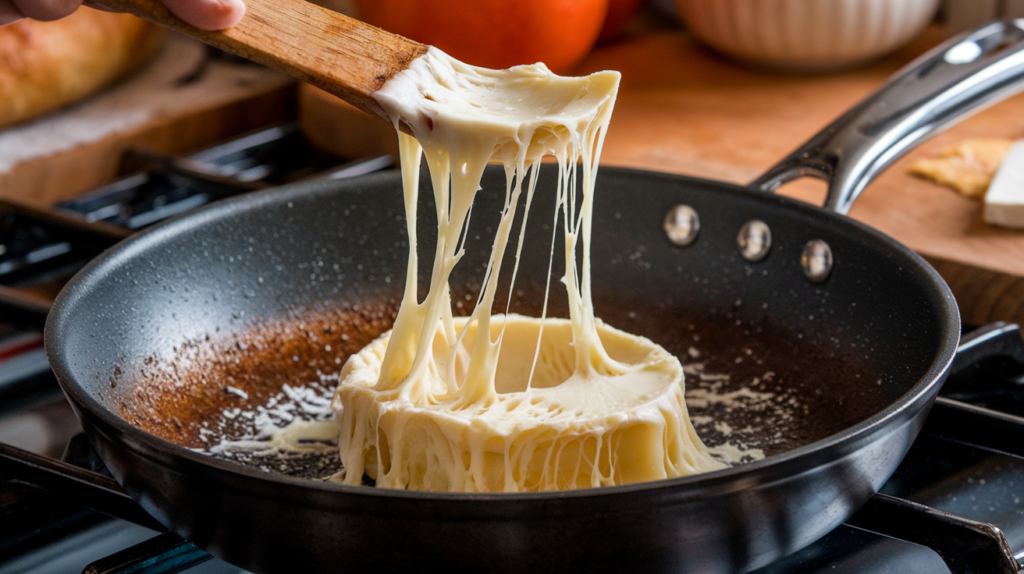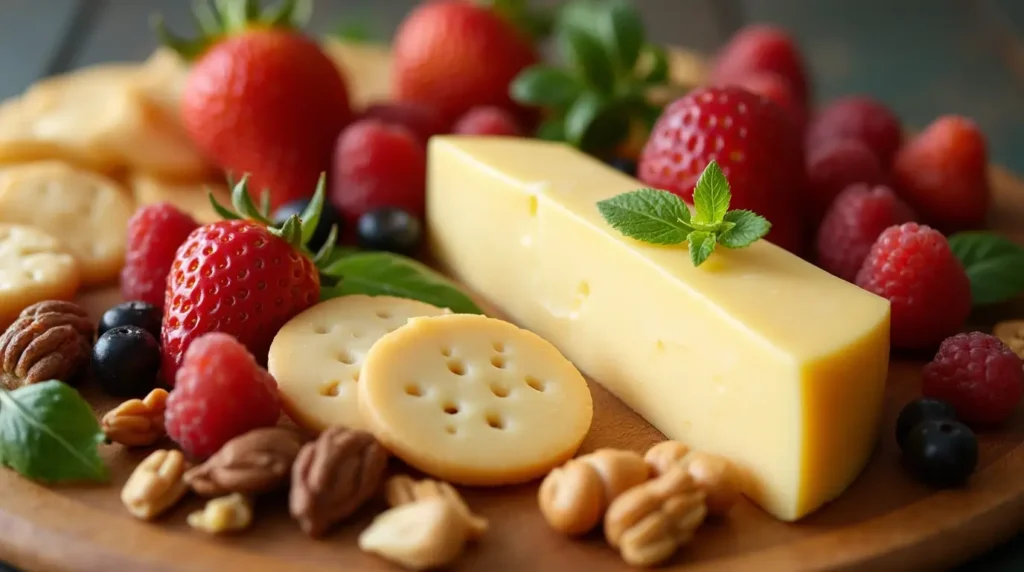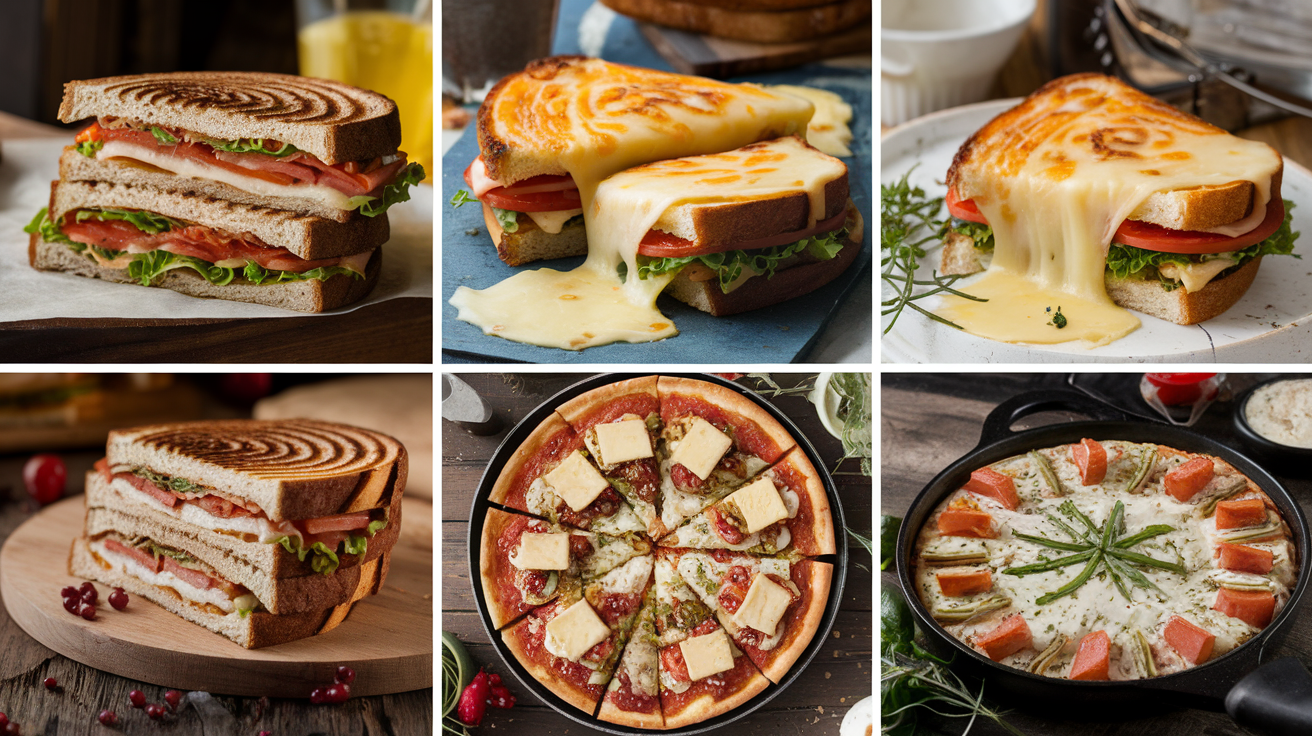Table of Contents
Provolone cheese, a semi-hard Italian cheese, is renowned for its distinctive characteristics, including a mild, nutty flavor and remarkable melting properties. Originating from southern Italy, this versatile cheese has gained immense popularity in various culinary traditions around the world. Often used in sandwiches, pasta dishes, and charcuterie boards, provolone cheese not only adds a creamy texture but also enriches the overall flavor profile of any dish.
One of the key attributes of provolone cheese is its exceptional melting quality, which not only enhances the sensory experience of a dish but also showcases the cheese’s unique traits. When melted, provolone transforms into a smooth and gooey delight, making it an excellent choice for toppings on pizzas, casseroles, and stuffed vegetables. This property plays a crucial role in why provolone cheese recipes are sought after by both home cooks and professional chefs alike.
Incorporating provolone into your cooking can elevate everyday meals into something extraordinary. From the best provolone cheese recipes suitable for quick weeknight dinners to elaborate dishes for special occasions, there is a wide variety of options to explore. Several provolone recipes feature this delightful cheese in numerous forms, such as slices, shreds, or melted. As you experiment with these best provolone recipes, you will discover how the cheese complements other ingredients, allowing you to create harmoniously balanced dishes.
By understanding the significance of achieving the perfect melt with provolone cheese, you can enhance both the texture and flavor of your culinary creations. Whether you’re a novice in the kitchen or a seasoned expert, mastering provolone cheese recipes will undoubtedly enrich your cooking repertoire, allowing you to bring the taste of Italy into your home.
Overview of Provolone Cheese
Provolone cheese is a semi-hard Italian cheese that boasts a rich history and distinct flavor profiles. Originating from southern Italy, particularly in regions such as Campania and Apulia, provolone has become a staple in Italian cuisine and is increasingly popular in culinary traditions worldwide. This cheese is produced from cow’s milk and comes in two prominent varieties: provolone dolce and provolone piccante.
Provolone dolce, meaning sweet provolone, is characterized by its mild flavor and creamy texture. It undergoes a shorter aging process, typically lasting between two to three months. This limited aging period allows the cheese to develop a gentle tanginess without overwhelming sharpness. Contrarily, provolone piccante, or sharp provolone, is aged for a significantly longer time, often exceeding four months, which enhances its bold and piquant flavor. The difference in aging not only influences the taste but also affects the cheese’s melting qualities, making each type uniquely suited for various culinary applications.
The melting quality of provolone cheese is one of its most celebrated attributes, and it finds its way gracefully into numerous delicious provolone recipes. Whether it’s for a classic Italian sandwich, a cheesy pasta dish, or a mouth-watering pizza, the beauty of provolone is that it melts exceptionally well, creating a delightful texture that enhances each dish. Many cooks and chefs consider both provolone varieties to be among the best provolone cheese recipes available, as they allow for a range of flavors and textures across meals. The use of provolone cheese has increasingly been embraced in gourmet cooking, elevating recipes to a new level of savory satisfaction.
Understanding Provolone Cheese
Provolone cheese is a semi-hard Italian cheese that has garnered a reputation for its versatility and rich flavor. The cheese is primarily categorized into two main types: provolone dolce and provolone piccante. Provolone dolce, or sweet provolone, typically undergoes a shorter aging process, lasting about two to three months. This type features a smoother, creamier texture and a mild, delicate flavor profile that makes it ideal for use in a variety of dishes, from salads to sandwiches. On the other hand, provolone piccante is aged for a much longer period, usually over four months, leading to a sharper taste and firmer texture. Its bold flavor makes it a compelling choice for cooking, as it can elevate dishes with its pronounced profile.
The aging process plays a crucial role in defining the characteristics of provolone cheese. During this time, natural bacteria and molds contribute to the development of flavor and texture. As provolone cheese matures, its texture transitions from smooth and creamy in the case of provolone dolce to a firmer and crumblier form with provolone piccante. These changes also affect how well the cheese melts, which is a significant consideration in culinary applications. For example, the best provolone cheese recipes often showcase the melting capabilities of provolone dolce, making it perfect for fondues or as a topping on various dishes. Conversely, provolone piccante is frequently utilized in recipes requiring a robust flavor, such as pasta dishes or savory pastries.
Understanding the distinct attributes of these two types of provolone is essential for selecting the right cheese for specific recipes. Whether you are exploring traditional provolone recipes or seeking the best provolone cheese recipes for contemporary dishes, knowing how aging influences flavor and melting properties will undoubtedly enhance your culinary experience.
Techniques for Melting Provolone Cheese

When it comes to incorporating provolone cheese into various dishes, mastering the art of melting is essential. Below are three reliable methods for achieving the perfect melt: the oven method, stovetop method, and microwave method.
Oven Method: Preheat your oven to 350°F (175°C). For this technique, slice the provolone cheese to your desired thickness, ensuring it melts evenly. Arrange the slices on a baking sheet lined with parchment paper to prevent sticking. Place the baking sheet in the oven and allow the cheese to melt for approximately 5 to 10 minutes. Keep an eye on it while melting; the goal is to achieve a gooey texture without overcooking. Remove it from the oven once it is soft and bubbly, making it perfect for using in layered provolone recipes or as a topping.
Stovetop Method: This method is ideal for those looking for quick results. Start by placing a non-stick skillet over medium heat. Cut the provolone cheese into small cubes or slices, as smaller pieces will melt faster. Once the skillet is warm, add the cheese, stirring frequently to encourage even melting. It typically takes about 3 to 5 minutes to melt completely. For best results, lower the heat if the cheese starts to bubble aggressively, allowing for a smooth melt without burning. This stovetop technique is excellent for making creamy sauces or adding to dishes like pizzas.
Microwave Method: The microwave is the fastest approach. Begin by placing provolone cheese on a microwave-safe plate or dish. Cover it with a microwave-safe lid or another plate to retain moisture. Set the microwave to medium power for about 30 seconds. Check the cheese and continue microwaving in 10-second intervals until melted. If overheating occurs, it could become rubbery, so monitor closely. This method is suitable for single servings or quick provolone cheese recipes.
Employing these techniques will provide you with versatile options for melting provolone cheese, enhancing flavor profiles across various dishes. Each method offers unique benefits, making it easier to incorporate this delicious cheese into your culinary endeavors.
Provolone Cheese Recipes

Provolone cheese, a flavorful and versatile ingredient, can be incorporated into various dishes to enhance their taste and texture. One of the most beloved choices among provolone recipes is the classic grilled cheese sandwich. By layering thick slices of provolone between two pieces of your favorite bread, you can create a satisfying meal that offers a perfect melt. For a gourmet twist, consider adding ingredients such as caramelized onions, sautéed mushrooms, or fresh herbs to elevate your sandwich experience.
Another popular way to highlight the creamy nature of provolone cheese is through baked ziti or lasagna. These comforting pasta dishes benefit from the rich flavor of provolone, which melts beautifully into the layers of cheese and sauce. Simply mix shredded provolone into your pasta mixture, or use it as a topping for the final layer before baking. This results in an irresistibly cheesy and hearty meal that is perfect for gatherings or weeknight dinners.
For those seeking delightful appetizers, stuffed mushrooms or a creamy cheese dip featuring provolone are excellent options. Stuffed mushrooms adorned with a blend of provolone cheese, garlic, and herbs can tantalize any palate. Alternatively, a provolone cheese dip, melted and served with crusty bread or fresh vegetables, can be a crowd-pleaser at parties or family gatherings.
In the realm of hearty main courses, dishes such as chicken parmesan and Philly cheesesteaks showcase the qualities of provolone cheese. The cheese melts incredibly well, creating a luscious topping that complements the savory elements of these meals. Whether you’re making homemade chicken parmesan or assembling the perfect cheesesteak, incorporating provolone cheese into your recipes guarantees a delightful dining experience.
In conclusion, the best provolone cheese recipes allow for a range of creative culinary endeavors. From sandwiches to pasta and appetizers to main dishes, the possibilities are endless when you include provolone cheese in your cooking.
Tips for Perfectly Melting Provolone
To achieve a perfect melt with provolone cheese, it is essential to be mindful of the temperature and cooking technique. One of the primary risks associated with overheating provolone is that it can become rubbery or separate, resulting in an undesirable texture. To prevent these issues, it is recommended to use low to medium heat when heating provolone. This approach allows the cheese to melt evenly without the danger of reaching a point of overheating.
When melting provolone in a dish, consider preprocessing the cheese into small slices or shreds. This helps to facilitate its melting process. For recipes that require cooking, such as pastas or casseroles, it may be beneficial to incorporate a liquid, such as broth or wine, which can help distribute the heat evenly and maintain a creamy consistency. Avoid direct flame or extremely high temperatures, as these can significantly detract from the intended texture and flavor of the best provolone cheese recipes.
Combining provolone with other cheeses is another excellent strategy to enhance both flavor and melting characteristics. When blended with mozzarella or fontina, for instance, you can achieve a delightful creaminess that elevates any dish. Moreover, the unique flavor profile of provolone pairs well with robust cheeses like aged gouda or sharp cheddar, creating an interesting blend that can surprise the palate.
Serving suggestions for melted provolone include pairing it with crusty bread for a classic cheese toast or incorporating it into sandwiches where a gooey, melt-in-your-mouth quality is desired. Additionally, incorporating provolone in gratins or layered dishes not only boosts the creaminess but also complements the accompanying ingredients beautifully. By following these tips, you can enjoy scrumptious provolone recipes that highlight the cheese’s unique attributes.
Serving Suggestions

Melted provolone cheese can elevate your dining experience with its rich, creamy texture and delightful flavor. To fully enjoy this versatile ingredient, consider a variety of serving suggestions that can complement its characteristics. One classic way to serve melted provolone is on a bed of crusty, warm bread. A fresh baguette or ciabatta can serve as the perfect vessel for the cheese, allowing you to appreciate the contrast in textures while indulging in the delightful combination.
Additionally, you might enhance your provolone cheese recipes by pairing them with fresh herbs. Basil, oregano, and parsley work particularly well and can add a burst of flavor that balances the richness of the cheese. Simply sprinkle these fresh herbs over your melted provolone for an aromatic touch that brightens the dish. Consider adding a drizzle of extra virgin olive oil or a dash of balsamic vinegar to elevate the flavors even further.
For a more elaborate presentation, you could serve melted provolone alongside an assortment of roasted vegetables. Zucchini, bell peppers, and cherry tomatoes are excellent choices that pair harmoniously with the cheese. Arrange the vegetables on a large platter and allow the melted provolone to cascade over them, creating a visually appealing centerpiece for your meal.
Another idea is to incorporate sliced meats such as prosciutto or salami. These salty accompaniments contrast beautifully with the cheese’s creamy consistency. For added texture, consider including crunchy pickles or olives, which will contribute to a delightful medley of flavors on your plate. Moreover, serving melted provolone with a side of fresh salads not only enhances the meal but also provides a refreshing balance to the dish.
By experimenting with these serving suggestions, you can create memorable culinary experiences that highlight the best provolone recipes while delighting your guests. Each combination allows for creativity and personalization, making melted provolone an endless source of inspiration in the kitchen.
Conclusion
Throughout this blog post, we have explored the versatile and delectable world of provolone cheese recipes. The melting properties of provolone cheese make it an ideal ingredient for various culinary endeavors, from sandwiches and pizzas to pastas and beyond. Understanding the proper techniques for melting provolone cheese is crucial for achieving the perfect texture and flavor in your dishes. Whether you prefer the mild sweetness of provolone dolce or the sharper taste of provolone piccante, the options for incorporating this cheese into your cooking are abundant.
The best provolone cheese recipes allow for creativity and experimentation in the kitchen, encouraging home cooks to incorporate this wonderful cheese into a variety of meals. From the classic melting of provolone atop a savory steak sandwich to innovative uses in baked casseroles, the potential for mouthwatering dishes is immense. Adopting the right melting methods will enhance your cooking, providing not only texture but also a delightful flavor profile that complements many ingredients.
We invite you to try the recipes shared in this post and to refine your techniques for melting provolone cheese. As you experiment with provolone recipes, you will undoubtedly discover how this cheese elevates your dishes and satisfies your palate. Embrace the versatility of provolone cheese and utilize it in your favorite meals, transforming them into culinary masterpieces. By doing so, you will unleash your culinary creativity and deepen your appreciation for one of the best cheeses available in the kitchen. Happy cooking!
Frequently Asked Questions
Provolone cheese, known for its delightful flavor and versatile uses in various dishes, often raises questions among cooks and cheese enthusiasts. One common question pertains to how to store provolone cheese effectively. To maintain its quality, provolone should be wrapped tightly in wax paper or parchment paper and stored in an airtight container in the refrigerator. This method helps prevent moisture loss while allowing the cheese to breathe, prolonging its freshness.
Another frequent inquiry revolves around the nutritional information of provolone cheese. Per one-ounce serving, provolone offers approximately 100 calories, making it moderately calorie-dense. It also provides around 7 grams of protein and 7 grams of fat, with a modest amount of calcium, contributing significantly to daily calcium intake. This makes provolone cheese not only a flavorful addition to meals but also a source of essential nutrients. For those monitoring their nutrition, it’s vital to incorporate provolone cheese recipes in moderation, ensuring a balanced diet.
Many individuals also wonder if provolone can be frozen for long-term storage. The good news is that provolone cheese can indeed be frozen, but it is advisable to shred or slice it before doing so. This allows for easier usage in various provolone recipes once thawed. When freezing, seal the cheese in a freezer-safe bag, removing as much air as possible to prevent freezer burn. When used in recipes after freezing, the texture may be slightly altered, but the flavor remains intact, allowing for continued enjoyment of the best provolone cheese recipes.
Ultimately, understanding how to store, analyze nutritional facts, and freeze this cheese can enhance your culinary experience and ensure you make the best of provolone cheese in your cooking endeavors.
Additional Resources and References
For those who have developed a keen interest in exploring provolone cheese recipes, numerous resources are available that can enhance understanding and culinary skills. Provolone cheese, known for its distinctive flavor and smooth melting qualities, is a versatile ingredient that can enrich a variety of dishes. To gain more insights, consider visiting reputable cooking websites that specialize in cheese, such as Cheese Making or Serious Eats. These platforms often feature expert tips, tricks, and a collection of the best provolone recipes that you can try at home.
Additionally, culinary books focused on cheese can serve as excellent references. Titles like “Cheese: A Connoisseur’s Guide to 150 Cheeses” or “The Complete Book of Cheese” offer in-depth information about different cheeses, including provolone, along with a variety of innovative provolone recipes. Local libraries or bookstores may have sections dedicated specifically to cheese-making and cooking, providing further options for exploration.
When it comes to purchasing high-quality provolone cheese, seeking out specialty cheese shops or local farmers’ markets is highly recommended. These venues often stock artisanal varieties that can elevate your culinary creations. Websites like Murray’s Cheese provide an easy online shopping experience for those looking to procure authentic and flavorful provolone. Furthermore, engaging with food communities on social media platforms can yield valuable recommendations and shared provolone recipes from fellow culinary enthusiasts.
Lastly, online cooking courses such as those from MasterClass can provide not only a foundational knowledge of cheese but also practical, hands-on experience in crafting dishes that highlight the delightful characteristics of provolone cheese. By utilizing these resources, readers can expand their culinary repertoire and enjoy experimenting with the best provolone cheese recipes available.


1 thought on “Provolone Cheese Recipes: How to Make the Perfect Melt”
Comments are closed.